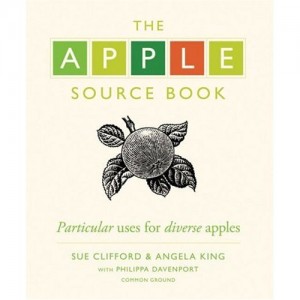from Common Ground
Apple Day, 21 October, was launched in 1990 by Common Ground. [Unlike birthdays the first event is counted hence this is the 18th anniversary]. The aspiration was to create a calendar custom. We have a way to go yet, but some already think the event is traditional. We should like the day to become the autumn holiday – what better celebration of a new era positively linking culture with nature.
From the start, it was intended to be both a celebration and a demonstration of the variety we are in danger of losing – not simply in apples, but richness and diversity of landscape, place, ecology and culture too. Its success has shown what the apple means to us and how much we need local celebrations in which, year after year, everyone can be involved. In city, town and country, Apple Day events have fostered local pride, celebrated and deepened interest in local distinctiveness.
Apple Day is now an integral part of the calendar of many villages, local authorities and city markets. It is a focus for activities organised by the Women’s Institute, National Trust properties, Wildlife Trusts, museums and galleries, horticultural societies, shops and restaurants as well as for schools, colleges and environmental study centres.
The first Apple Day celebrations, in the old Apple Market in London’s Covent Garden, brought fruit to the market after 16 years’ absence. Forty stalls were taken. Fruit growers and nurseries producing and selling a wide variety of apples and trees rubbed shoulders with juice-and cider-makers, as well as writers and illustrators with their apple books.
Representatives of the WI came laden with chutneys, jellies and pies. Mallorees School from North London demonstrated its orchard classroom, while the Hertfordshire & Middlesex Wildlife Trust explained how it manages its orchard for wild life. Marks & Spencer helped to start a trend by offering tastings of some of the 12 ‘old varieties’ they had on sale that autumn. Organic growers were cheek by jowl with beekeepers, amidst demonstrations of traditional and modern juice presses, a calvados still and a cider bar run by the Campaign for Real Ale. Experts such as Joan Morgan identified apples and offered advice, while apple jugglers and magicians entertained the thousands of visitors – far more than we had expected – who came on the day.
For two weeks before Apple Day, in a marquee on the Piazza, Common Ground exhibited the photographs of West Country Orchards we had commissioned from James Ravilious alongside a display of more than 100 different apple varieties. People were amazed at the diversity of shapes, sizes and colours. We also offered lunchtime tastings of some of the varieties on show, and many people bemoaned the lack of such choice on supermarket shelves.
We will never know just how many people came to that first celebration – it was certainly thousands and even now we meet people who effuse about it as a memorable event. Many wanted it to be repeated, but our intention was to spread the idea far and wide, encouraging people to celebrate Apple Day for themselves in their own city, village, parish, allotment or garden orchard.
And so the tradition of Apple Day began. Over the next few years, the number of events being organised around the country grew from more than 60 in 1991 to 300 by 1997 and over 600 in 1999, some attracting thousands of people. Apple Day has played a part in raising awareness not only of the importance of orchards to our landscape and culture, but to the growing interest in locality and in the provenance and traceability of food. It has been one impetus behind the developing network of farmers’ markets and is helping people everywhere to discover they are not alone in valuing the links between food and the land, between natural resource use and the impact we have on nature.
We have used the apple as a symbol of what is being lost in many aspects of our lives and shown that anyone can take positive action towards change. Over the years, Apple Day has been celebrated in a wonderful variety of ways by a diverse range of people. Doctor’s surgeries, coronary support groups, the Cancer Research Campaign have taken Apple Day as a novel way of encouraging healthy eating. Each year, alongside tasting, juicing, baking, pruning and grafting, an imaginative array of games and creative activities have flourished – ranging from simple apple printing to mummers’ apple plays, new songs and poetry evenings. But invariably, year after year, the most popular event is the display, tasting and buying of numerous varieties of apples and the presence of an expert to aid identification.
